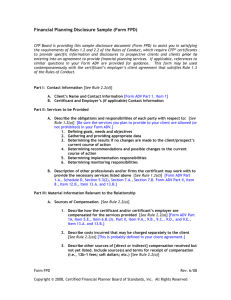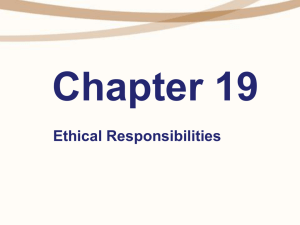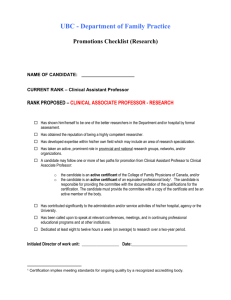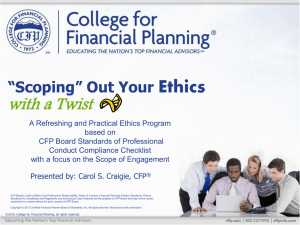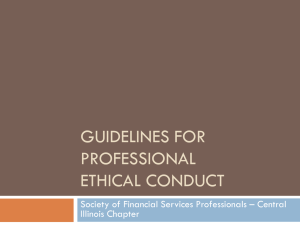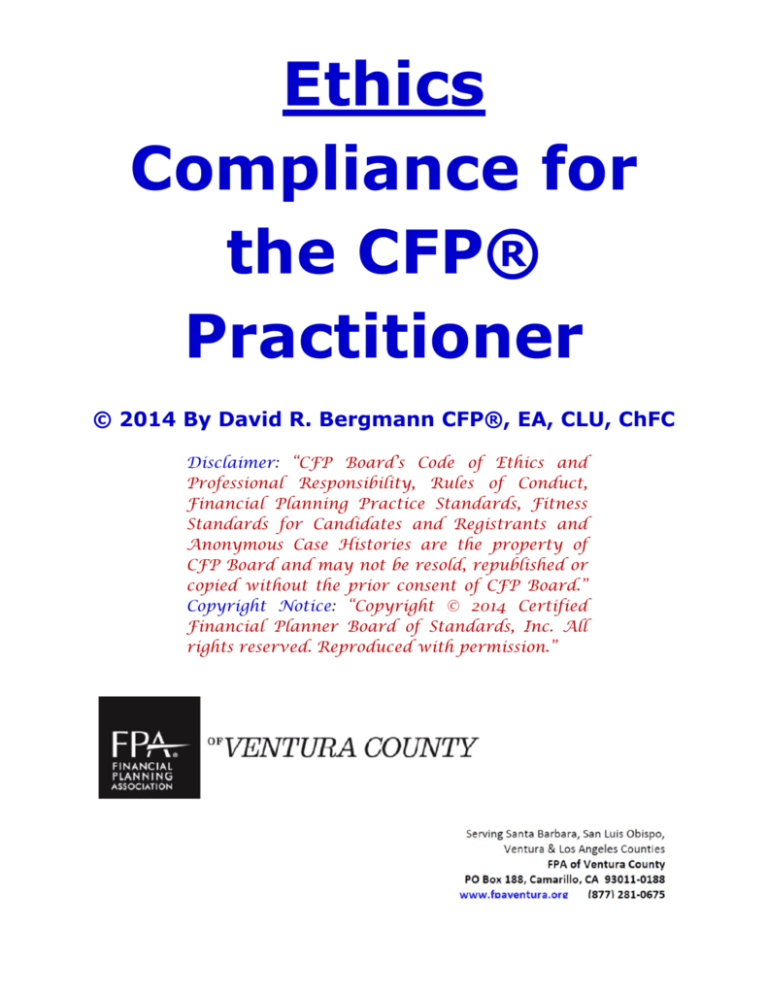
Ethics
Compliance for
the CFP®
Practitioner
© 2014 By David R. Bergmann CFP®, EA, CLU, ChFC
Disclaimer: “CFP Board’s Code of Ethics and
Professional Responsibility, Rules of Conduct,
Financial Planning Practice Standards, Fitness
Standards for Candidates and Registrants and
Anonymous Case Histories are the property of
CFP Board and may not be resold, republished or
copied without the prior consent of CFP Board.”
Copyright Notice: “Copyright © 2014 Certified
Financial Planner Board of Standards, Inc. All
rights reserved. Reproduced with permission.”
Program Timeline In Minutes
0 – 10:00 minute
Intro
Practice Round
10:00 minutes to 55:00 minutes
Learning Objectives
Define elements of the fiduciary standard [LO1].
Determine when the fiduciary standard applies in a variety of financial
planning contexts and scenarios. [LO2].
55:00 minutes to 1:05 minutes
Break
1:05 minutes to 2:10 minutes
Learning Objectives
Determine if a CFP® professional is providing financial planning or material
elements of financial planning [LO3].
Explain the CFP Board’s compensation disclosure requirements to clients and
prospective clients.
Explain the two disclosure requirements (1) the
beginning of the client engagement providing a general description of how
the client would pay for all of the services of the CFP® professional; and (2)
at the time the CFP® Professional makes specific recommendations to the
client/prospective client. [LO4]
Communicate any potential conflicts of interest to a client at the initiation of
client engagement. Explain the disclosure requirements – (1) given at the
beginning of the client engagement providing a general description of the
CFP® professional’s conflicts of interest; and (2) disclosures required to be
provided if a new conflict arises. [LO5]
RULES OF CONDUCT
1. DEFINING THE RELATIONSHIP WITH THE PROSPECTIVE
CLIENT OR CLIENT
1.1
The certificant and the prospective client or client shall mutually agree upon
the services to be provided by the certificant. [one mention in practice standards]
1.2
If the certificant’s services include financial planning or material elements of
financial planning, prior to entering into an agreement, the certificant shall provide
written information or discuss with the prospective client or client the following:
[four mentions in practice standards]
a. The obligations and responsibilities of each party under the agreement with respect
to:
i.
Defining goals, needs and objectives,
ii.
Gathering and providing appropriate data,
iii.
Examining the result of the current course of action without changes,
iv.
The formulation of any recommended actions,
v.
Implementation responsibilities, and
vi.
Monitoring responsibilities.
b. Compensation that any party to the agreement or any legal affiliate to a party to
the agreement will or could receive under the terms of the agreement; and factors
or terms that determine costs, how decisions benefit the certificant and the relative
benefit to the certificant.
c. Terms under which the agreement permits the certificant to offer proprietary
products.
d. Terms under which the certificant will use other entities to meet any of the
agreement’s obligations.
If the certificant provides the above information in writing, the certificant shall
encourage the prospective client or client to review the information and offer to
answer any questions that the prospective client or client may have.
1.3
If the services include financial planning or material elements of financial
planning, the certificant or the certificant’s employer shall enter into a written
agreement governing the financial planning services (“Agreement”).
The
Agreement shall specify: [one mention in practice standards]
a. The parties to the Agreement,
b. The date of the Agreement and its duration,
c. How and on what terms each party can terminate the Agreement, and
d. The services to be provided as part of the Agreement.
The Agreement may consist of multiple written documents. Written documentation
that includes the items above and is used by a certificant or certificant’s employer
in compliance with state or federal law, or the rules or regulations of any applicable
self-regulatory organization, such as the Securities and Exchange Commission’s
Form ADV or other disclosure documents, shall satisfy the requirements of this
Rule.
1.4
A certificant shall at all times place the interest of the client ahead of his or
her own. When the certificant provides financial planning or material elements of
financial planning, the certificant owes to the client the duty of care of a fiduciary as
defined by CFP Board. [four mentions in practice standards]
2. INFORMATION DISCLOSED TO PROSPECTIVE CLIENTS
AND CLIENTS
2.1
A certificant shall not communicate, directly or indirectly, to clients or
prospective clients any false or misleading information directly or indirectly related
to the certificant’s professional qualifications or services. A certificant shall not
mislead any parties about the potential benefits of the certificant’s service. A
certificant shall not fail to disclose or otherwise omit facts where that disclosure is
necessary to avoid misleading clients. [two mentions in practice standards]
2.2
A certificant shall disclose to a prospective client or client the following
information: [three mentions in practice standards]
a. An accurate and understandable description of the compensation arrangements
being offered. This description must include:
i.
Information related to costs and compensation to the certificant and/or the
certificant’s employer, and
ii.
Terms under which the certificant and/or the certificant’s employer may receive any
other sources of compensation, and if so, what the sources of these payments are
and on what they are based.
b. A general summary of likely conflicts of interest between the client and the
certificant, the certificant’s employer or any affiliates or third parties, including, but
not limited to, information about any familial, contractual or agency relationship of
the certificant or the certificant’s employer that has a potential to materially affect
the relationship.
c. Any information about the certificant or the certificant’s employer that could
reasonably be expected to materially affect the client’s decision to engage the
certificant that the client might reasonably want to know in establishing the scope
and nature of the relationship, including but not limited to information about the
certificant’s areas of expertise.
d. Contact information for the certificant and, if applicable, the certificant’s employer.
e. If the services include financial planning or material elements of financial planning,
these disclosures must be in writing. The written disclosures may consist of multiple
written documents. Written disclosures used by a certificant or certificant’s
employer that includes the items listed above, and are used in compliance with
state or federal laws, or the rules or requirements of any applicable self-regulatory
organization, such as the Securities and Exchange Commission’s Form ADV or other
disclosure documents, shall satisfy the requirements of this Rule.
The certificant shall timely disclose to the client any material changes to the above
information.
3. PROSPECTIVE CLIENT AND CLIENT INFORMATION AND
PROPERTY
3.3
A certificant shall obtain the information necessary to fulfill his or her
obligations. If a certificant cannot obtain the necessary information, the certificant
shall inform the prospective client or client of any and all material deficiencies.
[three mentions in practice standards]
3.4 A certificant shall clearly identify the assets, if any, over which the certificant
will take custody, exercise investment discretion, or exercise supervision. [one
mention in practice standards]
4 . OBLIGATIONS TO PROSPECTIVE CLIENTS AND CLIENTS
4.1
A certificant shall treat prospective clients and clients fairly and provide
professional services with integrity and objectivity. [seven mentions in practice
standards]
4.4
A certificant shall exercise reasonable and prudent professional judgment in
providing professional services to clients. [six mentions in practice standards]
4.5
In addition to the requirements of Rule 1.4, a certificant shall make and/or
implement only recommendations that are suitable for the client. [seven mentions
in practice standards]
KEY DEFINITIONS …
“Fiduciary.” One who acts in utmost good faith, in a manner he or she reasonably
believes to be in the best interest of the client.
“Personal financial planning” or “financial planning” denotes the process of
determining whether and how an individual can meet life goals through the proper
management of financial resources. Financial planning integrates the financial
planning process with the financial planning subject areas. In determining whether
the certificant is providing financial planning or material elements of financial
planning, factors that may be considered include, but are not limited to:
The client’s understanding and intent in engaging the certificant.
The degree to which multiple financial planning subject areas are involved.
The comprehensiveness of data gathering.
The breadth and depth of recommendations.
Financial planning may occur even if the material elements are not provided to a
client simultaneously, are delivered over a period of time, or are delivered as
distinct subject areas. It is not necessary to provide a written financial plan to
engage in financial planning.
“Personal
financial
planning
process” or “financial
planning
process” denotes the process which typically includes, but is not limited to, some
or all of these six steps:
Establishing and defining the client-planner relationship,
Gathering client data including goals,
Analyzing and evaluating the client’s current financial status,
Developing and presenting recommendations and/or alternatives,
Implementing the recommendations, and
Monitoring the recommendations.
C F P B OA R D D I S C LO S U R E G U I D E
The certification trademark above is owned by Certified Financial Planner Board of Standards, Inc. in the United States
and is awarded to individuals who successfully complete CFP Board’s initial and ongoing certification requirements.
As a CFP® professional, you are required to make certain oral and/or written disclosures at certain
times during client/prospect engagements. This document is designed to assist CFP® professionals
and their firms in determining when to make disclosures, what disclosures to make and which of
their existing documents can be used to meet the disclosure requirements.
This guide is organized into two sections. The first is for Financial Planning engagements and the
second is for all other engagements.
The organization of the guide focuses on five key areas:
■ When?: This column indicates the timing of when the disclosure is required.
■ How?: This column indicates the exact method of disclosure ----- oral or written. Please
note that there is no requirement to provide these disclosures in a single disclosure
document. This information can be provided in multiple documents or, in the case of nonfinancial
planning
engagements
or
prior
to
engaging
in
a
financial
planning
arrangement, orally. As a best practice, we recommend that CFP® professionals make all
disclosures in writing.
■ Rule: This column refers to CFP Board’s Rules of Conduct; if you need further clarification,
please refer to the full booklet for CFP® professionals which can be accessed on the website
at www.cfp.net.
■ What?: This column provides a detailed summary of the information that is required to be
disclosed. Use this section to ensure that the documents you are using contain all of this
required information.
■ Documents used for compliance: You may need to supplement a firm’s disclosures with
additional disclosure documents. For example, while Form ADV may assist a CFP® professional
in making initial disclosures regarding the different types of compensation he or she may
receive, the CFP® professional is required to supplement this disclosure with more detailed
and specific disclosures regarding the compensation and costs a particular client may incur.
In instances where disclosures can be oral, the ‘‘What?’’ column notes the items that must
be discussed. CFP® professionals who do not use standardized disclosure documents such
as Form ADV may use other documents provided by their firm or the documents referenced
below. CFP Board has developed sample disclosure forms and a sample engagement letter,
which are referenced when applicable.
We hope this guide is helpful to you in maintaining compliance with CFP Board’s disclosure
requirements. Please share it with other CFP® professionals or individuals at your firm who oversee
or support financial planning, or work directly with clients or prospects.
Type of Engagement: Financial Planning
When?
How?
Rule
What?
Prior to Entering
into Financial
Planning
Agreement.
Oral or
Written.
1.2
a. The obligations and responsibilities of
each party under the agreement with
respect to:
These disclosures
are typically made
at the first or
second meeting
with the client.
As a best
practice,
CFP Board
recommends
that CFP®
professionals
make these
disclosures
in writing.
Documents Used for Compliance
i. Defining goals, needs and objectives,
o Form ADV Part 2(A): Item 4; and
ii. Gathering and providing
appropriate data,
o Scope of Engagement and/or
a Meeting Summary Letter.
iii. Examining the result of the current
course of action without changes,
iv. The formulation of any
recommended actions,
v. Implementation responsibilities, and
vi. Monitoring responsibilities.
b. Compensation that any party to the
5(e); agreement or any legal afliate to a party
to the agreement will or could receive
under the terms of the agreement; and
how decisions benefit the certificant and
o Form ADV Part 1(a): Item
o Form ADV Part 2(a):
Items 5, 6, 10, 12, 14; and
Planning Agreement, Investment
CFP Board’s Form FPD and/or
Form FPDA.
c. Terms under which the agreement
and permits the certificant to ofer
proprietary products.
d. Terms under which the certificant
1(a): will use other entities to meet any
of the agreement’s obligations
o Form ADV Part 1(a): Item 8;
o Form ADV Part 2(a): Items 11
and 14.
o Form ADV Part
Items 8, 9, 10;
o Form ADV Part 2(a):
Items 10, 12 and 14; and
o Scope of Engagement, Financial
Planning Agreement, Investment
Advisory Agreement and/or CFP
Board’s Form FPD
In the Financial
Planning
Agreement.
A CFP® professional
should give the
financial planning
agreement to the
client prior to
providing any
services but
after the CFP®
professional and
the client have
mutually defined
the scope of the
engagement.
Written
1.3
The financial planning services
agreement shall specify:
a. The parties to the Agreement,
b. The date of the Agreement
and its duration,
o Scope of Engagement, Financial
Planning Agreement, Investment
Advisory Agreement and/or
CFP Board’s Form FPDA.
c. How and on what terms each party
can terminate the Agreement, and
d. The services to be provided
as part of the Agreement
o Form ADV Part 1(a): Item 5(g);
o Form ADV Part 2(a): Item 4; and
o Scope of Engagement, Financial
Planning Agreement, Investment
Advisory Agreement and/or
CFP Board’s Form FPDA.
Type of Engagement: All Engagements
When?
How?
Rule
What?
Prior to Providing
Services and as
material changes
occur.
Non-Financial
Planning: Oral
2.2
a. An accurate and understandable
5(e); description of the compensation
arrangements being ofered.
This description must include:
A change is
material if it
could impact
a reasonable
client’s ability
to make an
informed
decision.
Financial
Planning:
Written
Documents Used for Compliance
o Form ADV Part 1(a): Item
o Form ADV Part 2(a): Items
5, 6, 10, 12, 14; and
o Scope of Engagement, Financial
Planning Agreement, Investment
Advisory Agreement, CFP Board’s
Form FPD and/or Form OPS.
i. Information related to costs and
compensation to the certificant and/
or the certificant’s employer, and
ii. Terms under which the certificant and/
or the certificant’s employer may receive
any other sources of compensation, and
if so, what the sources of these payments
are and on what they are based.
b. A general summary of likely conflicts
8; of interest between the client and the
certificant, the certificant’s employer or
any affiliates or third parties, including,
but not limited to, information about any
familial, contractual or agency relationship
of the certificant or the certificant’s employer
that has a potential to materially afect the
relationship.
o Form ADV Part 1(a): Item, 6, 7,
c. Any information about the certificant or the
certificant’s employer that could reasonably
be expected to materially afect the client’s
decision to engage the certificant that the
client might reasonably want to know in
establishing the scope and nature of the
relationship, including but not limited to
information about the certificant’s areas
of expertise.
o Scope of Engagement;
Investment Advisory Agreement
or CFP Board’s Form OPS and/or
Form FPD.
d. Contact information for the certificant and,
1; if applicable, the certificant’s employer
o Form ADV Part 1(a): Item
and/or
o Form ADV Part 2(a): Items
5, 10, 11, 12 and 14; and
o Scope of Engagement, Financial
Planning Agreement, Investment
Advisory Agreement, CFP Board’s
Form FPD and/or Form OPS.
o Form ADV Part 2(b).
C E R T I F I E D F I N A N C I A L P L A N N E R B O A R D O F S TA N D A R D S , I N C .
1 4 2 5 K ST N W # 8 0 0
n
P 8 0 0 - 4 8 7-1 4 97
WA S H I N G TO N D C 2 0 0 0 5
n
F 2 0 2 - 379 - 2 2 9 9
M A I L @ C F P B OA R D.O R G
n
C F P. N E T
Printed on recycled paper.
C F P B OA R D S TA N D A R D S
OF PROFESSIONAL CONDUCT
COMPLIANCE CHECKLIST
Client Name:Date Completed:
Meeting Attendees:
The certification trademark above is owned by Certified Financial Planner Board of Standards, Inc. in the United States
and is awarded to individuals who successfully complete CFP Board’s initial and ongoing certification requirements.
This checklist is designed to help CFP® professionals document an initial client
consultation in accordance with CFP Board’s Standards. The questions contained
in this checklist reflect both the requirements of the Standards and established
best practices for complying with the Standards.
Except for Section A(2), all boxes should be completed for compliance purposes.
This checklist should be periodically reviewed throughout the course of your
relationship with your client.
Section A: Determining the Scope of the Engagement
1.
❏❏ Define the Scope of the Engagement:
Rule 1.1, and Practice Standard 100-1
❏❏ Have I determined and documented the client’s
understanding and intent in working with me?
❏❏ Have I determined and documented the extent and
Note: After analyzing and evaluating the
client’s data in Step 2 of Sections B and C,
you may need to redefine the scope of
your engagement.
2.
❏❏ Entering into a Client Agreement:
Rules 1.2 and 1.3 and Practice
Standard 100-1
breadth of the services I am providing? (See the
Personal Financial Planning Subject Areas in the
Terminology Section of the Standards)
❏❏ Have I determined and documented the level of data
gathering I plan to do?
Based on Answers above, is this client a financial
planning client?
❏❏ Yes. Have I entered into a written agreement
(see sample Form FPDA on www.cfp.net) and
documented that I have made the required written
disclosures (see sample Form FPD on www.cfp.net)?
(See Rules 1.2, 1.3 and 2.2)
Proceed to Section B.
❏❏ No. Have I documented that I have orally-made
disclosures? (See Rule 2.2)
Proceed to Section C.
Section B: Financial Planning Engagement Checklist
Note: A CFP® professional shall act in utmost good faith, in a manner he or she reasonably believes to be in
the best interest of the client.
1.
❏❏ Gathering Client Data:
Rule 3.3 and Practice Standards
200-1 and 200-2
❏❏ Have I determined and documented the client’s
goals and objectives?
❏❏ Have I documented my discussion with the client
of any unrealistic goals and objectives?
❏❏ Have I documented the client data I gathered
and any gaps in the data?
2.
❏❏ Analyzing and evaluating
the client’s data:
Rules 2.1 and 4.5 and
Practice Standard 300-1
Note: After analyzing and evaluating the client’s
data, you may need to return to Step 1 in Section
A and redefine the scope of your engagement.
3.
❏❏ Developing and presenting
recommendations:
Rules 2.1 and 4.5 and Practice
Standards 400-1, 400-2 and 400-3
Note: You may need to update your
disclosures depending on the products
and services you are recommending.
❏❏ Have I documented my analysis and
evaluation of the client’s data?
❏❏ Have I documented the personal and
economic assumptions I used in developing
my recommendations?
❏❏ Have I considered maintaining the client’s current
course of action?
❏❏ Have I considered and documented appropriate
alternatives to the client’s current course of action?
❏❏ Have I documented a cost/benefit analysis of the
various products?
❏❏ Have I documented how the alternatives are
designed to meet the client’s goals and objectives?
❏❏ Have I documented how my proposed
recommendations are designed to meet
the client’s goals and objectives?
❏❏ Have I documented my discussion with the
client regarding the client’s current situation
and the rationale for my recommendations?
4.
❏❏ Implementing the Recommendations:
Rules 2.1 and 4.5 and Practice
Standards 500-1 and 500-2
❏❏ Have I documented the client’s acceptance
or rejection of my recommendations?
❏❏ Have I determined and documented my
responsibility regarding implementation?
❏❏ Have I disclosed and documented conflicts
of interest, sources of compensation and
material relationships that have not been
previously disclosed?
❏❏ Have I selected appropriate products designed
to meet the client’s goals and objectives?
5.
❏❏ Monitoring: Practice Standard 600-1
❏❏ Have I discussed and documented my
role in monitoring the performance
of my recommendations?
Section C: Non-Financial Planning Engagement Checklist
Note: This section represents the minimum standards required of CFP® professionals in all financial
engagements. As a best practice, CFP® professionals are encouraged to use the Financial Planning
Engagement checklist in Section B in all client engagements.
1.
❏❏ Gathering Client Data:
Rule 3.3
❏❏ Have I obtained all the information necessary to fulfill
my obligation to client? If not, have I informed the
client of any and all material deficiencies?
Note: Depending on the comprehensiveness
of your data gathering, you may need to return
to Section A to reevaluate whether you are
providing financial planning services or material
elements of financial planning services.
2.
❏❏ Developing and presenting
recommendations:
Rules 1.4, 2.2 and 4.5
Note: Depending on the depth and breadth
of your recommendations, you may need to
return to Section A to reevaluate whether
you are providing financial planning services
or material elements of financial planning
services.
3.
❏❏ Implementing the Recommendations:
Rules 1.4, 2.2 and 4.5
❏❏ Do my recommendations place the interests of
my client ahead of my own?
❏❏ Have I disclosed conflicts of interest, sources
of compensation and information that may be
material to the client regarding our relationship
that have not been previously disclosed?
❏❏ Have I only made recommendations that are
suitable for the client?
❏❏ Does the recommendation that I am implementing
on behalf of the client place the interests of my client
ahead of my own?
❏❏ Have I disclosed conflicts of interest, sources of
compensation and information that may be material
to the client regarding our relationship that have not
been previously disclosed?
❏❏ Have I implemented only recommendations that
are suitable for the client?
Printed on recycled paper.
Investigative and Hearing Process
Full details of this process are contained in CFP Board’s Disciplinary Rules and Procedures
Grievance Assign to
Compliance Analyst
Self‐Disclosure
Notice of Investigation
(response due
within 30 days)
Dismiss with Caution or Dismiss No Merit
Staff‐Discovered
Dismiss without Investigation
Analyze response and documents received
Discovery & Evidence
Continue Investigation
Issue Complaint
(Answer due within 20 days; documents, $1500 hearing fee
and attorney and witness identification due 45 days before hearing)
Pre‐hearing Meeting on Preliminary Motions
Hearing
Copyright © 2013, Certified Financial Planner Board of Standards Inc. All rights reserved.
Decision
Order
(within 45 days of hearing)
Petition for Appeal
(within 30 days of
Decision Order)

